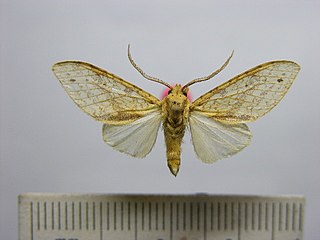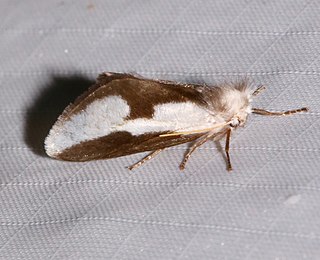
Norape is a genus of moths in the family Megalopygidae. The genus was erected by Francis Walker in 1855.
Repnoa is a genus of moths in the family Megalopygidae. It contains only one species, Repnoa imparilis, which is found in French Guiana.

Araeomolis rubens is a moth of the family Erebidae. It was described by William Schaus in 1905. It is found in French Guiana, Venezuela, Peru, Suriname and the Brazilian state of Amazonas.

Lophocampa debilis is a moth of the family Erebidae. It was described by William Schaus in 1920. It is found in Mexico, Costa Rica and Guatemala.
Givira plagiata is a moth in the family Cossidae. It was described by William Schaus in 1901 and is found in Venezuela.
Conchylodes nissenalis is a moth in the family Crambidae described by William Schaus in 1924. It is found in Peru.
Phostria cleodalis is a moth in the family Crambidae. It was described by William Schaus in 1920. It is found in Bolivia.
Syllepte nebulalis is a moth in the family Crambidae. It was described by William Schaus in 1920. It is found in Peru.
Megalopyge braulio is a moth of the family Megalopygidae. It was described by William Schaus in 1924. It is found in Paraguay.
Megalopyge lapena is a moth of the family Megalopygidae. It was described by Schaus in 1896. It is found in Mexico and southern Arizona.
Megalopyge radiata is a moth of the family Megalopygidae. It was described by William Schaus in 1892. It is found in Mexico and Brazil.
Megalopyge torva is a moth of the family Megalopygidae. It was described by Schaus in 1912. It is found in Costa Rica.
Mesoscia lorna is a moth of the family Megalopygidae. It was described by William Schaus in 1905. It is found in French Guiana.
Mesoscia terminata is a moth of the family Megalopygidae. It was described by William Schaus in 1905. It is found in Costa Rica and French Guiana.
Mesoscia pascora is a moth of the family Megalopygidae. It was described by William Schaus in 1900. It is found in Brazil.

Norape tener, the mesquite stinger moth, is a species of moth in the family Megalopygidae. It was described by Herbert Druce in 1897. It is found in Mexico and the south-western US.
Podalia albescens is a moth of the family Megalopygidae. It was described by William Schaus in 1900. It is found in Brazil.
Podalia schadei is a moth of the Megalopygidae family. It was described by William Schaus in 1924. It is found in Paraguay.
Podalia thanatos is a moth of the Megalopygidae family. It was described by William Schaus in 1905. It is found in Costa Rica and Guyana.

Dugonia is a monotypic genus of moths in the family Notodontidae, containing only the species Dugonia eliera. The genus and species were both first described in 1928 by William Schaus from an unspecified number of female specimens from the Dognin collection. It is known from French Guiana, with a type locality in Saint-Laurent-du-Maroni.




